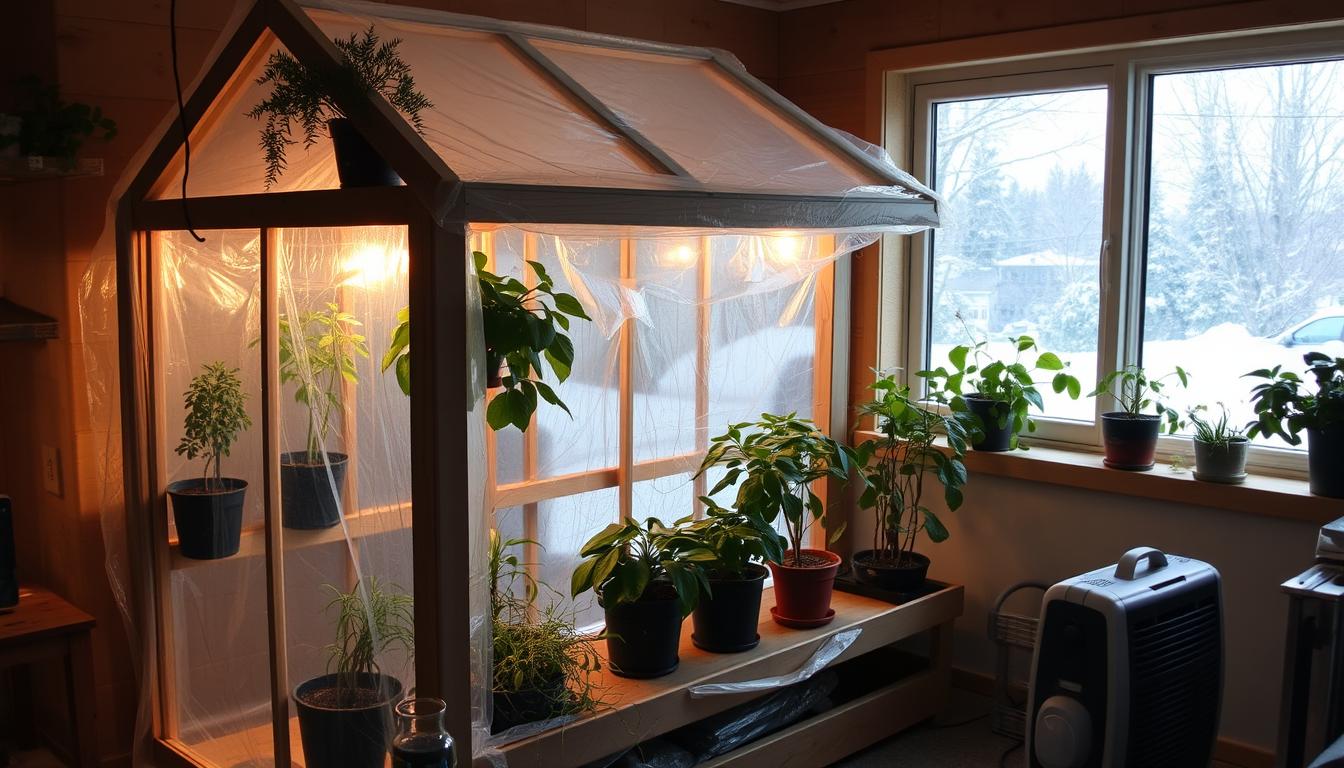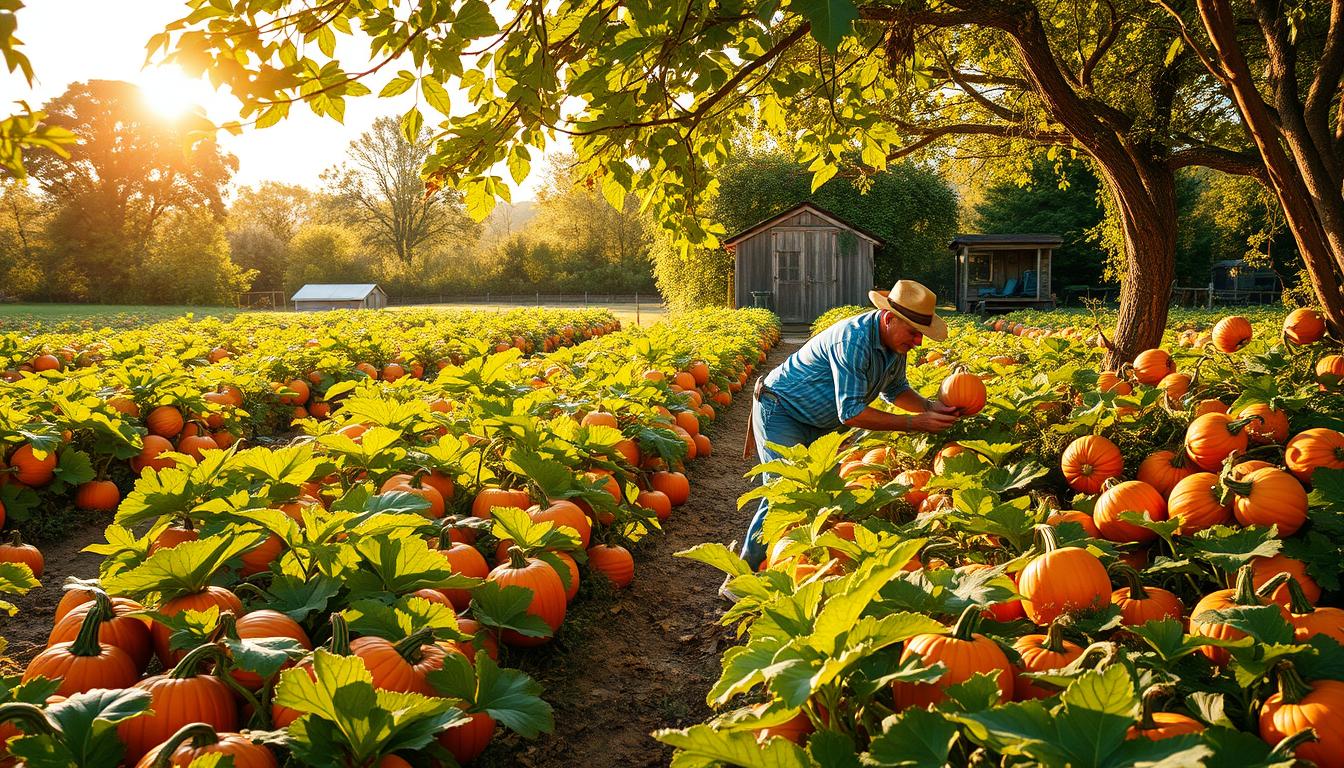
Winter can be tough for those who love indoor gardening. But, a DIY greenhouse is a great way to keep your plants safe and healthy. It turns any space into a green oasis.
Plant lovers are finding new ways to care for their plants in winter. They use old IKEA cabinets and recycled containers to make greenhouses. This way, they create cozy spots for plants to grow.
Building your own greenhouse is easy. You just need some basic materials and a little creativity. This way, you can make a warm spot for your plants to thrive, even when it’s cold outside.
Key Takeaways
- DIY greenhouses protect plants during winter months
- Multiple affordable materials can be used for construction
- Small spaces can become productive plant sanctuaries
- Grow lights and humidity control are essential for success
- Customizable solutions fit various plant care needs
Understanding the Benefits of Indoor Winter Greenhouses
Indoor winter greenhouses are a big help for those who love plants and want to keep them safe in the cold. They make taking care of plants a fun activity all year round.
By using affordable greenhouse solutions, gardeners can keep their plants growing longer. They also protect plants from the harsh cold of winter.
Protection from Cold Weather and Temperature Control
Winter can be tough on plants. Indoor greenhouses act as a shield, keeping plants warm and safe. Grow lights are key in these spaces, providing plants with the light they need.
- Consistent temperature regulation
- Protection from frost and cold winds
- Controlled humidity levels
Enhanced Plant Growth Environment
An indoor greenhouse creates a perfect spot for plants to grow. It keeps plants safe from outside stress, helping them grow strong and healthy.
| Environmental Factor | Greenhouse Impact |
|---|---|
| Temperature | Stable and controlled |
| Humidity | Optimized for plant needs |
| Light Exposure | Consistent and adjustable |
Cost-Effective Gardening Solution
DIY winter greenhouses are a budget-friendly way to garden all year. By using what you already have and smart design, you can make a great plant shelter without spending a lot.
*”A well-designed indoor greenhouse transforms limited space into a thriving botanical sanctuary.”*
Essential Materials and Tools for Your DIY Greenhouse Project
Creating a sustainable gardening space needs careful planning and the right materials. DIY winter greenhouse projects are getting more popular. Now, 50% of enthusiasts use everyday items to make unique plant protection spaces.

When starting a cold frame gardening project, picking the right materials is key. Here are the essential parts for your indoor greenhouse:
- Structural Options:
- Glass cabinets (IKEA Fabrikor, Rudsta, Milsbo)
- Recycled aquariums
- Picture frames
- Plastic containers
Important tools for your windowsill greenhouse include:
- Grow lights for optimal plant growth
- Humidifiers to keep moisture
- Ventilation fans
- Climate control accessories
“The right materials transform a simple space into a thriving plant sanctuary” – Oakland Community Garden Coordinator
Material choices affect your greenhouse’s success. Here are some comparisons:
| Material Type | Pros | Cons |
|---|---|---|
| Glass | Durable, attractive | Expensive, fragile |
| Plastic | Affordable, lightweight | Requires annual replacement |
Pro tip: 25% of successful greenhouse projects are designed for compact spaces. This shows that size isn’t everything in sustainable gardening.
More supplies you’ll need for your winter greenhouse include:
- Drainage pebbles
- High-quality potting soil
- Appropriate planters
- Temperature monitoring devices
Creating a DIY Winter Greenhouse for Your Indoor Plants
Urban gardening fans are finding new ways to care for plants in the cold. A DIY winter greenhouse is a fun project that makes plant care creative and sustainable.

Building an indoor greenhouse needs careful planning and the right materials. The right steps can make a great space for your plants to thrive.
Choosing the Right Cabinet or Container
Picking the right container is key for your DIY greenhouse. Here are some ideas:
- Glass-fronted cabinets for lots of light
- Repurposed furniture with clear doors
- Custom-built wooden structures
- Clear plastic containers with good air flow
Installing Proper Lighting Systems
Lighting is vital for indoor plants to grow. Modern LED grow lights are efficient and adaptable for urban gardening.
| Grow Light Type | Best For | Average Cost |
|---|---|---|
| LED Grow Lights | Herbs, Leafy Vegetables | $20-$50 |
| Full Spectrum Lights | Flowering Plants | $30-$75 |
| Compact Grow Lights | Succulents, Small Plants | $15-$35 |
Setting Up Climate Control Features
Keeping the right growing conditions is important. Think about adding:
- Small humidifiers for moisture
- Digital temperature monitors
- Compact fans for air flow
- Thermal insulation materials
Creating an indoor greenhouse is about understanding your plants’ unique needs and providing them a nurturing microclimate.” – Urban Gardening Expert
With good planning and creativity, your DIY winter greenhouse can be a beautiful part of your home. It will also help your plants grow well during the cold months.
Smart Design Solutions for Small Spaces

Turning small areas into green havens for winter plants needs creativity and smart gardening tips. People who garden on a budget can make amazing greenhouses from everyday items.
Indoor gardeners can use unexpected spots for plants. Innovative ideas turn common household items into amazing green spaces.
- Windowsill mini greenhouses using recycled picture frames
- Converted side tables with integrated greenhouse sections
- Vertical shelving units for maximum space efficiency
- Repurposed glass display cases as plant habitats
“Creativity transforms small spaces into plant havens with minimal investment.”
Compact greenhouses are very versatile. For example, mason jar greenhouses with 3D-printed bases show how new ideas can change indoor gardening.
| Space Type | Greenhouse Potential | Cost Estimate |
|---|---|---|
| Windowsill | Small herb garden | $20-$50 |
| Side Table | Compact plant collection | $30-$75 |
| Vertical Shelving | Multiple plant zones | $50-$150 |
LED grow lights and small fans can make any corner a perfect spot for winter plants. Try these budget-friendly ideas to grow plants in the most surprising places.
Maintaining Optimal Growing Conditions
To have a successful indoor greenhouse, you need to focus on key environmental factors. These support sustainable living and protect plants from cold weather. Your DIY plant shelters must be managed carefully to help plants grow well in winter.

Good plant care involves several important elements. These elements work together to create the perfect growing space.
Temperature and Humidity Management
Keeping the right temperature is vital for plant survival. Most plants do best in temperatures between 75-90 degrees Fahrenheit, with 80 degrees being the sweet spot. Managing humidity is also key to plant health:
- Use a digital hygrometer to track moisture levels
- Implement misting systems for increased humidity
- Place water trays near plants to boost ambient moisture
Lighting Schedule and Intensity
Natural light is hard to get in winter, so artificial light is a must. Indoor plants need 14-16 hours of artificial sunlight each day. Here are some tips:
- Install full-spectrum LED grow lights
- Position lights 6-12 inches above plant canopies
- Use timers to maintain consistent light exposure
“Proper lighting mimics natural daylight and supports robust plant growth” – Indoor Gardening Experts
Ventilation Requirements
Good air circulation is crucial to prevent fungal growth and keep plants healthy. Small fans can help move air and keep temperatures steady in your indoor greenhouse.
- Use oscillating fans for gentle air movement
- Ensure consistent air exchange
- Monitor temperature differences between day and night
By using these strategies, you can make a thriving indoor plant space. This supports gardening all year and sustainable living.
Conclusion
Building a DIY winter greenhouse is a great way to extend your growing season. It can cost anywhere from $50 to $50,000. This lets gardeners create greenhouses that fit their needs and space.
It’s important to keep the temperature inside below 90°F. This helps plants grow well. Creative designs make sustainable plant cultivation possible.
Features like automatic window openers and temperature control help protect plants. You can use materials like polypropylene or metal roofing. This makes greenhouses flexible and customizable.
DIY winter greenhouses are a fun way to grow plants year-round. They work for small indoor spaces or bigger outdoor ones. The goal is to create a space that helps plants thrive.
With good planning and materials, your greenhouse can become a lush oasis. It’s not just about protecting plants. It’s about bringing life and color to your home all year.
FAQ
Q: What materials can I use to create a DIY indoor greenhouse?
A: You can use many materials for a DIY indoor greenhouse. Options include glass cabinets, like IKEA’s Fabrikor or Milsbo, and plastic containers. You can also use recycled aquariums, picture frames, and repurposed furniture. IKEA cabinets, clear plastic containers, and old picture frames are popular choices.
Q: How do I control temperature and humidity in my indoor greenhouse?
A: To control temperature and humidity, start by placing your greenhouse near a window. Use heating mats for warmth and a small humidifier for moisture. Fans help with air circulation. Use humidity trays or mist plants occasionally to keep moisture levels right.
Q: What type of lighting should I use for my indoor greenhouse?
A: Grow lights are key for indoor greenhouses, especially in winter. LED grow lights are energy-efficient and mimic natural sunlight. Place lights for even coverage and follow a 12-14 hour light schedule for most plants.
Q: Can I create a greenhouse in a small space?
A: Yes, you can! Use windowsills, converted side tables, vertical shelving, and compact cabinets for small spaces. Miniature greenhouses can be made from picture frames, recycled containers, or small glass cabinets. Focus on using vertical space and choosing containers that fit your area.
Q: How do I protect my plants from pests in an indoor greenhouse?
A: Keep pests away by ensuring good air flow and avoiding too much water. Regularly check your plants for pests. Use neem oil or insecticidal soap if needed. Keep your greenhouse clean and ventilated. Quarantine new plants before adding them to your collection to prevent pests.
Q: What are the best plants for an indoor winter greenhouse?
A: Tropical and subtropical plants do well in indoor greenhouses in winter. Good choices include succulents, orchids, ferns, African violets, and plants like monstera, pothos, and philodendron. Pick plants that like similar temperatures and humidity for the best environment.
Q: How much does it cost to create a DIY indoor greenhouse?
A: Costs vary, from to 0 or more, based on materials and complexity. Repurposing furniture, using plastic containers, or converting an old cabinet are budget-friendly options. IKEA cabinets cost 0-0, and grow lights are -0. It’s a relatively affordable project for gardeners.






